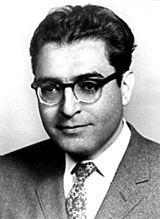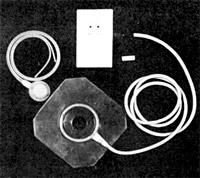Inventing the Radio-Frequency Controlled, Implantable Cardiac Pacemaker

Mauro, Alexander
In the late 1950s several research groups developed cardiac pacemakers. The first prototypes had generators carried outside the body and wire leads inserted through the skin, which were often a source of infection. In 1958 biophysicist Alexander Mauro (1921-1989) and heart surgeon William Glenn (1914-2003) at the Yale University School of Medicine collaborated to invent a pacemaker that used radio-frequency stimulation, a technique that transmits electrical energy through radio waves. The device's receiver was surgically implanted under the skin; a transmitter outside the body broadcast a signal that was picked up by the receiver and converted into pulses that stimulated the heart muscle. This innovative approach allowed for longer-term use of the pacemaker because the patient did not have an open wound. In addition, the rate and amplitude of the signal could be adjusted—or even turned off completely—if the settings were not optimal or if the patient's condition changed.
Mauro and Glenn first tested the radio-frequency pacemaker in 1959 in a patient with heart block-a failure of electrical impulses to travel from the heart's upper chambers to its lower chambers to make a coordinated heart beat. That year Mauro came to Rockefeller, where he continued his collaboration with Glenn and also enlisted the expertise of Lawrence Eisenberg, then an engineer in Rockefeller's electronic laboratory. Eisenberg designed a transistorized and battery operated version of the pacemaker. Between 1959 and 1965, 26 patients at the Yale-New Haven Medical Center and the National Institutes of Health received the device, which was by then manufactured by an outside company. The researchers reported in the journal Science that the radio frequency induction technique "has come to play an important role in the treatment of heart block in human patients, where medication has been ineffective."

Radio-frequency cardiac pacemaker. From Annals of New York Academy of Science, 1964, 111: 992-1006
At Rockefeller Mauro also studied the physiology of muscle cells, and in 1961 he discovered and named satellite cells. Based only on the appearance of the nuclei of these small cells with scant cytoplasm, he made the remarkable deduction that "these cells...might be pertinent to the vexing problem of skeletal muscle regeneration." Subsequent studies by other investigators demonstrated that these cells are what we now term muscle stem cells and that they can differentiate into muscle cells (myocytes) when the muscle is damaged or heavily used. Of note, hematopoietic stem cells, the cells in the bone marrow that produce all of the blood cells were discovered in the same year that Mauro made his landmark observation.
Alexander Mauro received the BE (1942) and the PhD (1950) from Yale University. He was a United States Public Health Junior Research Fellow (1947-1950) and did postdoctoral research at the Institute of Neurophysiology, Copenhagen (1950-1951). In 1951 Mauro joined the faculty of the Yale University School of Medicine. In 1959 he moved to the Rockefeller laboratory of Frank Brink as assistant professor. Mauro was named associate professor in 1963 and full professor in 1971.
Lawrence Eisenberg received the BEE from City College of New York (1944) and the PhD from the Polytechnic University of Brooklyn (1965). He joined Rockefeller in 1958 and was named assistant professor in 1966, and later senior research associate. He then became co-head of the Laboratory of Electronics with Robert L. Schoenfeld, PhD. Eisenberg became emeritus in 1984 and continued to teach at Rockefeller until 2000.
Selected Publications
Glenn WW, Mauro A, Longo E, Lavietes PH, Mackay FJ. Remote stimulation of the heart by radiofrequency transmission. Clinical application to a patient with Stokes-Adams syndrome. N Engl J Med, 1959, 261: 948-951
Toole AL, Longo E, Mauro A, and Glenn WW. Prolonged electrical stimulation of the heart. Surg Forum, 1960: 11: 247-249
Eisenberg L, Mauro A, and Glenn WW. Transistorized pacemaker for remote stimulation of the heart by radio-frequency transmission. IRE Trans Bio Med Electron, 1961, 8: 253
Widmann WD, Glenn WW, Eisenberg L, and Mauro A. Radio-frequency cardiac pacemaker. Ann N Y Acad Sci, 1964, 111: 992-1006
Eisenberg L, Mauro A, Glenn WW, and Hageman JH. Radiofrequency stimulation: A research and clinical tool. Science, 1965, 147: 578-582
Mauro A. Satellite cell of skeletal muscle fibers. J Biophys Biochem Cytol, 1961, 9: 493-495
http://jcb.rupress.org/cgi/reprint/9/2/493
Further Reading
Jeffrey K. Machines in Our Hearts: The Cardiac Pacemaker, the Implantable Defibrillator, and American Health Care. Baltimore: The Johns Hopkins Univ Press, 2001
